What Animals Can Live In A 2 Gallon Tank
The one thing I dearest virtually Paludariums is that they can accommodate terrestrial, aquatic, and semi-aquatic species, and so you no longer must determine between your favorite terrarium or aquarium animals. Paludariums are a contempo discovery of mine, so I was excited to get and do a lot of inquiry to try and find the best animals that are suited for a Paludarium environment.
Beneath you will find a range of semi-aquatic, aquatic, and terrestrial animals that would all brand great pets within your Paludarium. For each of the animals listed, I take included some central data that yous will want to recall about if considering any of these interesting creatures.
Always use circumspection when introducing multiple species within the same surround every bit some species do not coexist well with others. It is important to understand the nutrition and maintenance requirements of your animals so that your Paludarium is a safe surround, and your animals can live in harmony.
1 of the best means to ensure a safe environment for your paludarium pets is to use plants that are suited for a paludarium environment. Check out this article I have written which contains a multifariousness of aquatic, semi-aquatic, and terrestrial plants that are perfect for any paludarium.
ane. Fire-Bellied Toad

Fire-bellied toads are a cracking pick for any Paludarium. They are great to look at and often coexist well with other animals and fish. Fire-bellied toads are easy to care for and can easily exist bred in captivity. I just honey the strange croaking dissonance they make which sounds similar a clinking bell.
| Name | Burn down-Bellied Toad |
| Creature Grade | Amphibian |
| Type | Semi-aquatic |
| Size | 2-3 inches long |
| Lifespan | x-xv years |
| Diet | Insects, Crickets, and Wax worms iii-4 times weekly |
2. Springtails

Springtails are small, wingless insects which often are perceived as pests. Withal, they are a great fit for a Paludarium, due to their adaptability and low maintenance requirements. They tin become without food for years at a time by recycling their own waste and tin can also be used as food for larger animals within your habitat. Springtails can spring up to 100 times their body tiptop and then be sure to have a covering on your Paludarium.
| Name | Springtail |
| Animal Grade | Invertebrate |
| Type | Semi-aquatic |
| Size | 0.2mm-10mm |
| Lifespan | 1 week to 3 years |
| Nutrition | Leaf litter, fine roots, mold/mildew, fungi |
three. Yellowish-Bellied Slider Turtle
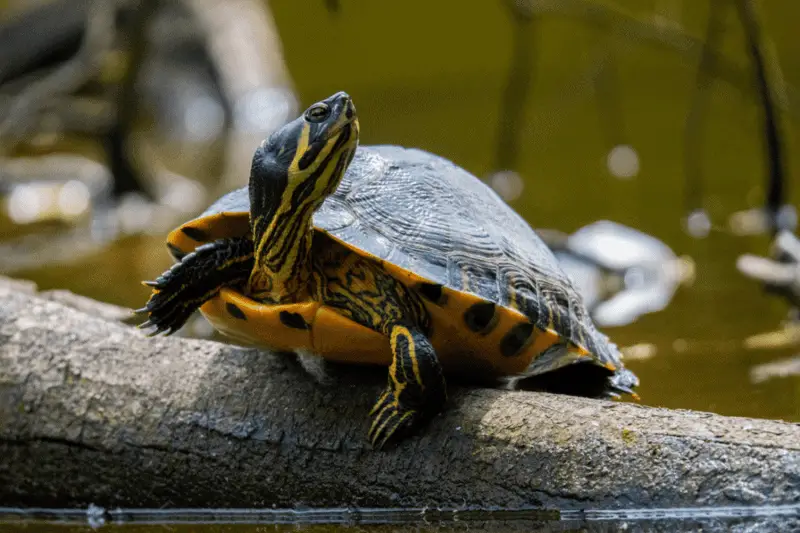
Xanthous-Bellied Sliders love to savour in the warmth, and then be sure to incorporate some floating logs for them to relax on. These colorful turtles beginning out primarily as carnivores when they are young, eating water insects and small-scale fish, however, every bit adults, their diet is predominantly vegetarian. If you are looking for fish that can coexist with your turtle instead of becoming tiffin, then smaller, agile fish are your best bet, like guppies or minnows.
| Proper name | Xanthous-Bellied Slider |
| Animal Class | Reptile |
| Blazon | Semi-aquatic |
| Size | Male person (5-9 inches) Female (8-13 inches) |
| Lifespan | upwards to 30-40 years |
| Diet | Leaves, roots, algae, water insects, pocket-size slower fish, Commercial turtle pellets |
four. Vampire Crab
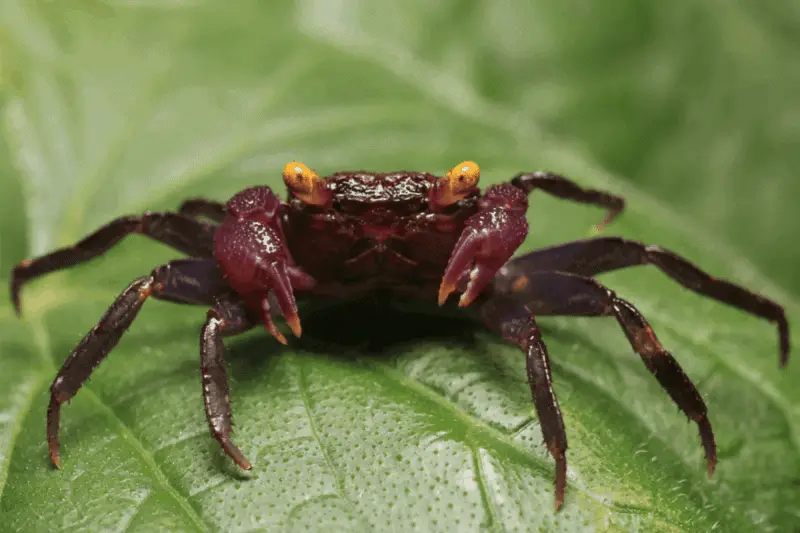
Vampire Crabs are actually unique and tin can add some great color to your Paludarium. They are known for their bright royal pincers and yellow eyes. You can keep up to half-dozen crabs in a 10 gallon tank and they tin can ofttimes coexist with other animals quite well. Merely be sure to find non-aggressive animals and fish of a similar size to your crabs to avoid any confrontations.
| Name | Vampire Crab |
| Animal Form | Invertebrate |
| Type | Semi-terrestrial |
| Size | up to two.5 inches wide |
| Lifespan | 2-3 years |
| Diet | Brine shrimp, bloodworms, crickets, green vegetables, algae wafers |
5. Fire-Bellied Newt

Fire-Bellied Newts love to spend most of their time in the h2o. Be careful of adding guppies to your Paludarium as larger Fire-Bellied Newts will often use them as a snack. A x gallon tank would exist suitable if your newt is on the smaller side, merely a larger tank size (min xx gallon) is commonly recommended if housing more than than ane. Fire-Bellied Newts are quite agile, so are cracking if you are looking for a more entertaining environment.
| Name | Burn-Bellied Newt |
| Animal Course | Amphibian |
| Type | Semi-aquatic |
| Size | 3-6 inches long |
| Lifespan | ten-25 years |
| Nutrition | Bloodworms (frozen or live), earthworms, brine shrimp |
half dozen. Mudskipper
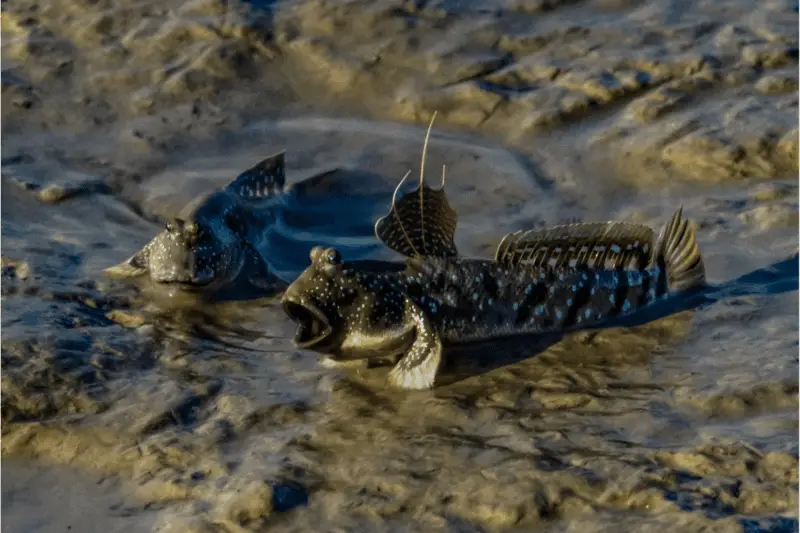
Mudskippers are a strange species of amphibious fish that have googly optics and enjoy being in the water and on state. Also known as "The Walking Fish", this fauna can be a great improver to your Paludarium. They will thrive in a swamp-similar surroundings consisting of stagnant water and mangrove roots and can as well be trained to eat nutrient straight out of your hand!
Mudskippers are territorial animals and can become quite aggressive if sharing a living space with other animals. Mudskippers can exist kept with similar sized fish, but they volition consume annihilation smaller. Guppies and Archer fish are ii peachy options that will make suitable Paludarium roommates.
| Proper name | Mudskipper |
| Animal Class | Amphibious Fish |
| Type | Semi-aquatic |
| Size | up to 12 inches |
| Lifespan | 3-20 years |
| Diet | Crickets, flies, worms, meal worms, beetles, small fish, pocket-size crabs |
7. Spring Salamander
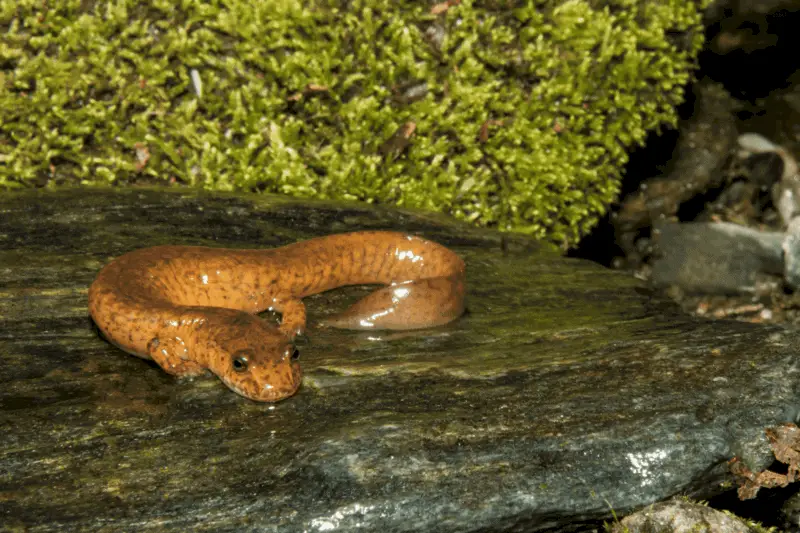
Jump Salamanders are primarily nocturnal creatures and will be most active at night. They require clean, well-oxygenated water, so its of import to keep upwards on your Paludarium maintenance and water changes. Bound salamanders are protected in some states in the The states, so be sure to research any restrictions in your state before buying this pet.
| Proper name | Bound Salamander |
| Animal Class | Amphibian |
| Type | Semi-aquatic |
| Size | 5-vii.5 inches long |
| Lifespan | 18.5 years |
| Diet | Insects, crustaceans, centipedes, millipedes, earthworms, snails, minor spiders |
8. African Bullfrog

Also known as the "Pixie" frog, African Bullfrogs are one of simply 3 frogs species that take teeth, so be careful when feeding or handling. Male African Bullfrogs are larger than females, so if your looking for a smaller pet for your Paludarium, and so a female might be your best choice. A medium-sized bullfrog requires at least a 10 gallon tank but the bigger the meliorate.
| Proper name | African Bullfrog |
| Animal Class | Amphibian |
| Type | Semi-aquatic |
| Size | 6-10 inches long |
| Lifespan | 15-40 years |
| Nutrition | Crickets, mealworms, insects, mice, babe rats, other modest amphibians |
9. Ribbon Ophidian
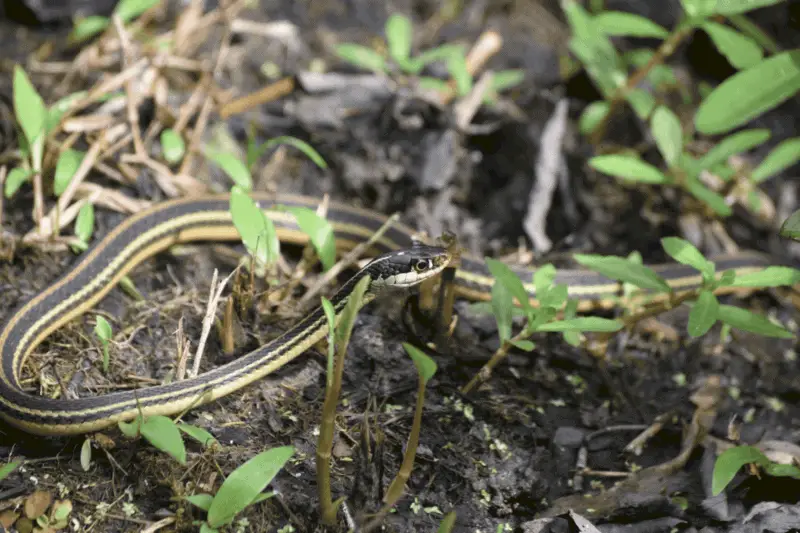
These nonvenomous snakes are perfect for first fourth dimension serpent owners and tin be a great addition to your Paludarium. Ribbon Snakes require little maintenance, and are easy to handle. They contain 3 distinct stripes that run the length of their body which they use to cover-up themselves into their environment to avoid predators.
| Name | Ribbon Ophidian |
| Brute Course | Reptile |
| Type | Semi-aquatic |
| Size | xvi-28 inches on average |
| Lifespan | 12-20 years |
| Diet | Small frogs, tadpoles, small fish, spiders, earthworms, eggs, terrestrial vertebrates, and pocket-sized newts |
10. Northern Water Serpent
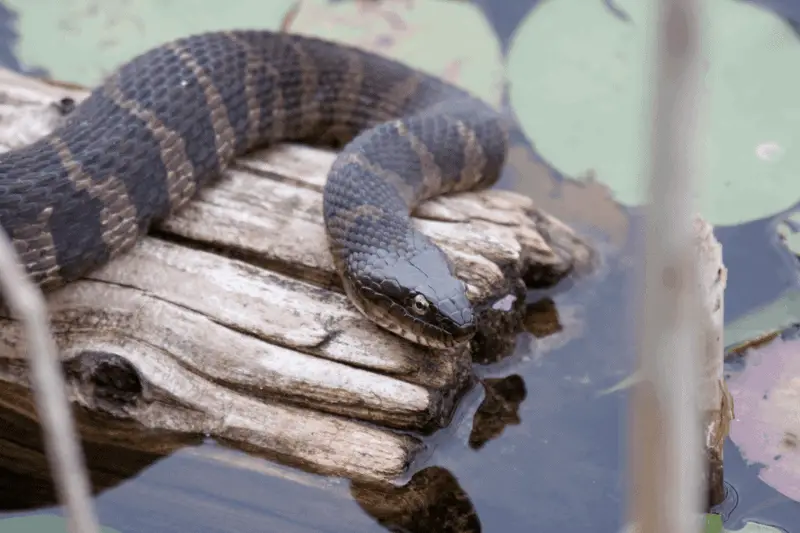
The northern water ophidian is the i of the more mutual species that you will detect in a Paludarium. Although they are nonvenomous, they tin be quite aggressive. And then handle with intendance and try to go on tank mates to a minimum. The northern water snake likes alive casualty and will overlook its food if it is deceased. They can often exist mistaken for the venomous water Moccasin, which you definitely don't desire within your Paludarium. So when looking to add this exciting pet to your enclosure, be certain you have the right type!
| Proper name | Northern H2o Ophidian |
| Animal Form | Reptile |
| Type | Semi-aquatic |
| Size | 2-4.5 ft |
| Lifespan | upwards to ix years |
| Nutrition | Fish, amphibians, pocket-size reptiles, worms, leeches, small crayfish, small birds, salamanders |
11. Caiman Lizard

Caiman Lizards are great for a Paludarium as they can coexist with nearly any fish and mainly eat snails instead. And then if you want to go on snails as well, and then be certain to take acceptable foliage and plants then your snails tin remain hidden. Caiman lizards derived their name due to their big, heavy scales that resemble the Caiman Crocodile. Equally they can counterbalance upwards to 10 pounds, be certain that your Paludarium has plenty of space.
| Name | Caiman Lizard |
| Beast Class | Reptile |
| Type | Semi-aquatic |
| Size | 2-4 ft |
| Lifespan | up to 10 years |
| Nutrition | Snails, crayfish, shrimp, crickets, chopped fruit |
12. Guppies
Guppies are also called "Rainbow Fish" as they tin come in a multitude of colors. They are a great choice of fish to take in your Paludarium and are extremely easy to intendance for.
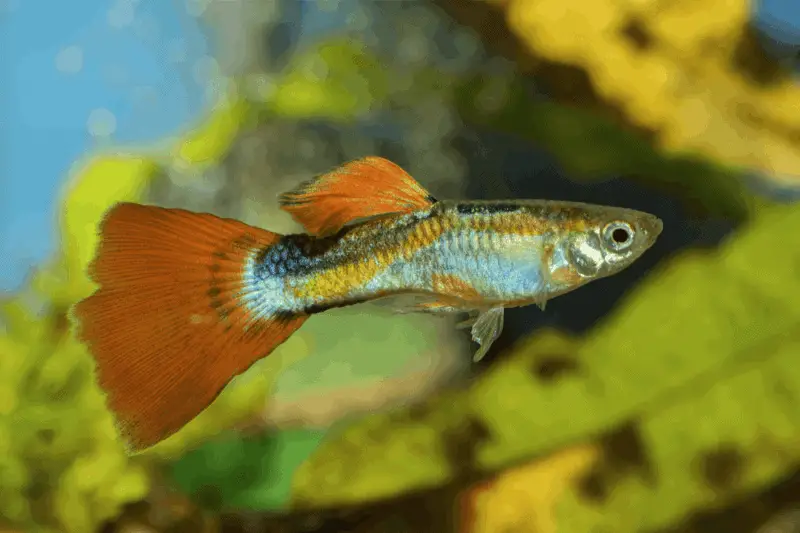
An interesting affair most guppies, is that they don't lay eggs. They give birth to live immature, which can be fun to watch. If yous are hoping to breed guppies or continue the offspring, and then make sure to add some actress plants for the infant guppies to hide as the parents tend to eat their young. Information technology is not recommended to remove the baby guppies as it can cause stress to the parents and pb to premature expiry.
If yous desire to know some other freshwater fish that would exist perfect for a Paludarium, then your in luck! See my article on fish that can live in a freshwater Paludarium, which I encourage you to read.
| Name | Guppies |
| Animal Class | Fish |
| Type | Aquatic |
| Size | Male (0.vi-1.4 inches) Female person (i.2-2.4 inches) |
| Lifespan | 1-3 years |
| Diet | Brine shrimp, algae, microorganisms, flakes, pellets |
13. Thai Micro Crab

Thai Micro Venereal are groovy for nano tanks or modest habitats. As they only get up to 0.v inches in size, the minimum tank requires is merely five gallons. The unique thing almost these fascinating venereal is that the only identify in the wild they be is ane specific river, the Tha Chin River, Nakhon Chai Si Commune, of the Nakhon Pathom Province, in Thailand.
| Name | Thai Micro Crab |
| Fauna Course | Invertebrate |
| Type | Aquatic |
| Size | up to 0.5 inches |
| Lifespan | upward to 1.v years |
| Diet | Shrimp food, sinking pellets, algae |
14. Mystery Snails

Mystery snails are a type of Apple Snail and are ane of the larger snail species you can discover for your Paludarium. They are great tank cleaners and would honey goose egg more than then to eat abroad all the algae they can find. If you are looking for good tank mates that can coexist with your snails without whatever bug, blood-red shrimp, corydoras catfish, and the African Butterfly fish are all great options.
An interesting fact nigh snails is that all snails are either right or left handed. This may seem odd considering they don't really have hands, but all snails tend to favor one side over the other. Apple snails in particular tend to be right handed.
| Proper noun | Mystery Snails |
| Brute Class | Invertebrate |
| Type | Aquatic |
| Size | ane-2 inches |
| Lifespan | up to 1 year |
| Nutrition | Algae, dead/rotting plants, fish/invertebrate pellets, blanched vegetables |
xv. Tadpoles
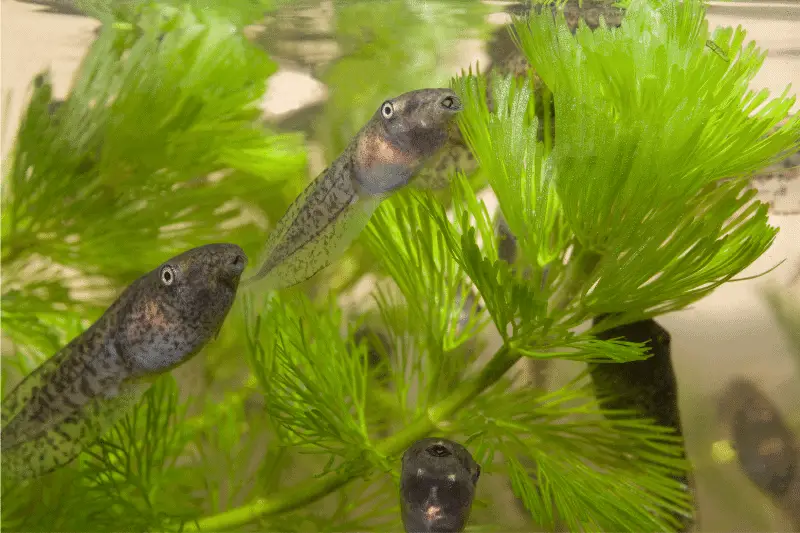
Tadpoles, as well know as Polliwogs, are generally used to universally depict babies from both frogs and toads. Even so, babies from toads take also been called as "toadpoles".
If you happen to have a Poison Dart Frog, Poison Dart Frog tadpoles have been known to ride on their mothers back during the early on stages of their life wheel. If y'all are looking for something a lilliputian bigger, Bullfrog tadpoles tin can get as big as a banana, so brand certain you do your inquiry so y'all tin be sure your tank tin can suit your specific species of tadpole.
| Proper name | Tadpoles |
| Animal Grade | Amphibian |
| Type | Aquatic |
| Size | Differs based on species. (1.3-viii inches) |
| Lifespan | Lifecycle from tadpole to frog betwixt 12-xvi weeks. |
| Diet | Algae, leaves/roots of aquatic plants, dead insects. As they grow legs they will first to be more than carnivorous. |
16. Axolotl
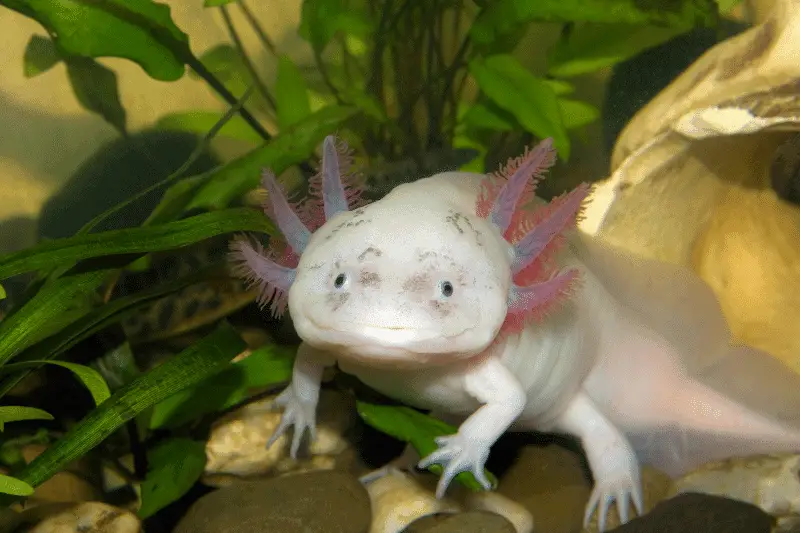
The Axolotl, as well known as the "Mexican Walking Fish", got its name later the Ancient Aztec deity, "Xolotl", which translates to "h2o Dog". In the wild, these unique creatures can only exist found in Mexico and accept the ability to regenerate lost limbs or body organs.
The Axolotl'southward feathery headdress isn't only for prove, its really gills that allow the fauna to jiff underwater. These fascinating animals are critically endangered and then be certain to acquire them through proper means and take skillful care of them!
| Name | Axolotl |
| Animate being Class | Amphibian |
| Blazon | Aquatic |
| Size | half-dozen-eighteen inches |
| Lifespan | Upwardly to 15 years |
| Nutrition | Mollusks, worms, insect larvae, small fish, brine shrimp |
17. Nerite Snail
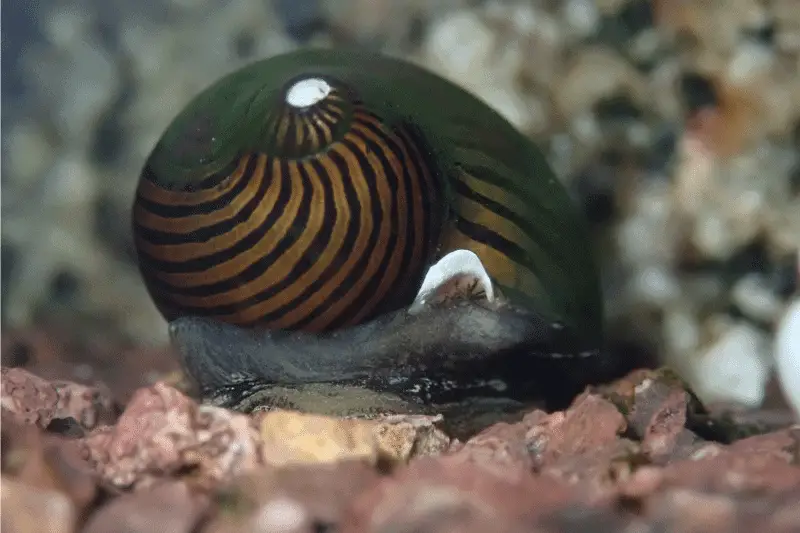
Nerite Snails are a must take for any Paludarium or aquarium. They are bully cleaners and can happily live in a tank of any size. Nerite snails are extremely versatile and tin coexist with any other animal in your Paludarium. That is, except ones that specifically hunt and eat snails. Nerite snails are like shooting fish in a barrel to find and can exist purchased at well-nigh local pet stores or through online retailers.
| Name | Nerite Snail |
| Animal Course | Invertebrate |
| Type | Aquatic |
| Size | upwards to one inch |
| Lifespan | i-ii years |
| Nutrition | Algae, blanched vegetables |
18. Aquatic Isopods
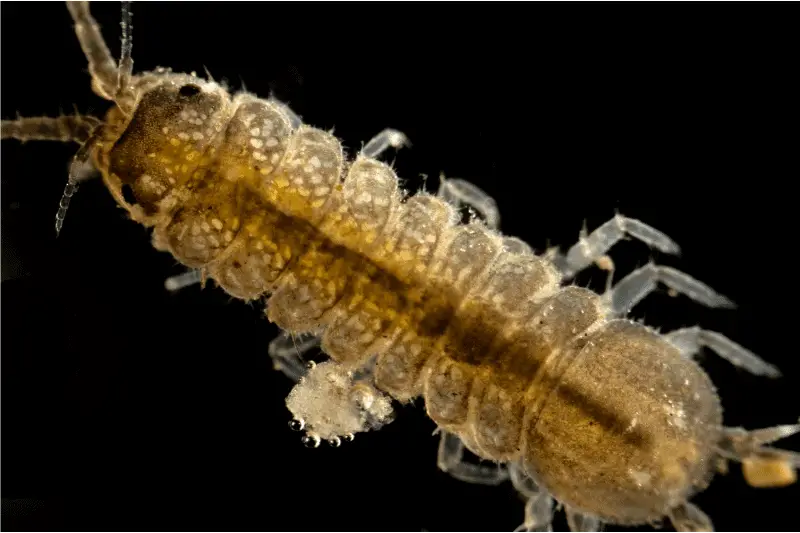
Aquatic Isopods, also known equally Aquatic Pillbugs or Sowbugs, are often used to gauge the quality of water. They tin be a great addition to your Paludarium and aid yous to keep an centre on your water health.
Biologists will conduct censuses of organisms living in streams and depending on the relative number of unlike species that they find, this tin can help them gain a better understanding if pollutants, siltation, and other factors are affecting h2o health.
Another interesting fact almost these unique creatures is that in that location is also a species of Giant aquatic isopods that take been known to reach 2.5ft long that are found deep in the body of water.
| Name | Aquatic Isopods |
| Animal Class | Invertebrate |
| Type | Aquatic |
| Size | 0.iii-0.5 inches |
| Lifespan | 9-20 months |
| Diet | Decaying establish material, algae, sinking pellets |
nineteen. Electrical Blue Crayfish
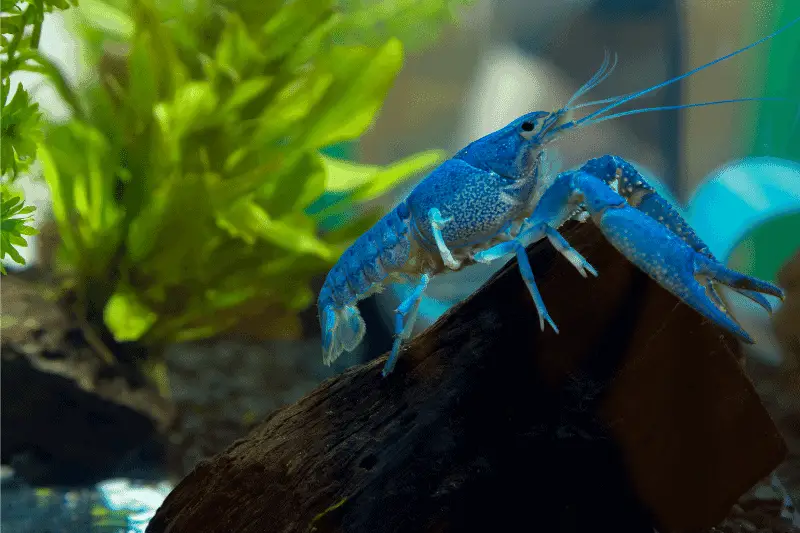
These freshwater crayfish can live in most any Paludarium or Aquarium and are relatively ho-hum moving so will not harm your fish or shrimp. Electrical Blue Crayfish are very agile and dear to explore. And then yous shouldn't accept whatever bug with them disappearing for most of the day while they hibernate under rocks or logs.
These fascinating crayfish are great tank cleaners and tin proceed your tank waste matter to a minimum. Due to their maximum potential size, they are best kept in tanks larger than 20 gallons. Crayfish can suit to about any surroundings, however, they are at their most vulnerable when they are shedding their exoskeleton. And then be sure to have plenty of live plants, logs, rocks, or other hiding places, where they can safely remain until a new one is grown.
| Proper noun | Electric Blueish Crayfish |
| Animal Class | Invertebrate |
| Type | Aquatic |
| Size | iv-6 inches |
| Lifespan | 5-6 years |
| Diet | Invertebrate pellets, blanched vegetables (carrots, zucchini, spinach), algae wafers |
20. Orange Mexican Dwarf Crayfish
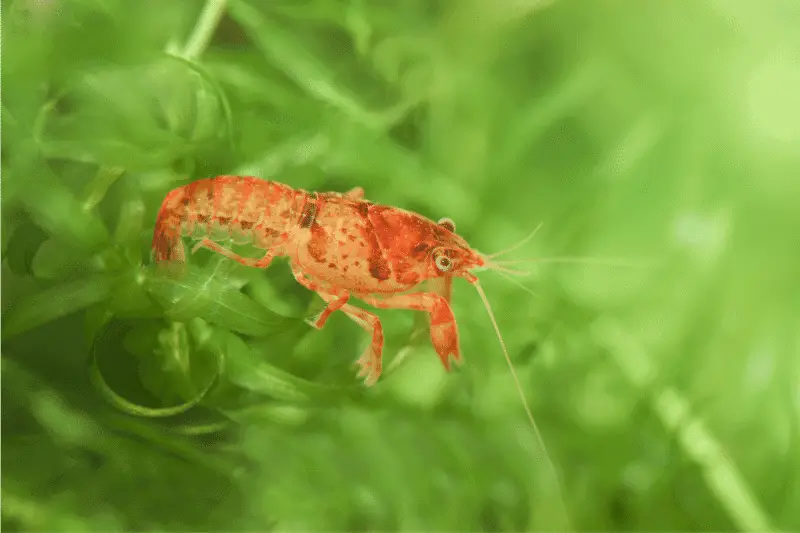
The Mexican Dwarf Crayfish, besides known as "CPO" crayfish, is a bully cleaning crew member and volition help to keep your tank spotless. As they are relatively small-scale in size, they can be housed in a 10 gallon or greater tank.
Dwarf crayfish have non been known to kill fish and then they can be kept in about community tanks without any issues. A filter is a must when keeping dwarf orange crayfish. Without it, the water in the tank won't cycle through and your crayfish will exist at run a risk.
| Name | Orange Mexican Dwarf Crayfish |
| Creature Class | Invertebrate |
| Type | Aquatic |
| Size | up to 1.six inches |
| Lifespan | 2-3 years |
| Diet | Worms, brine shrimp, plants, vegetables, algae wafers, pellets |
21. Blue Dream Shrimp
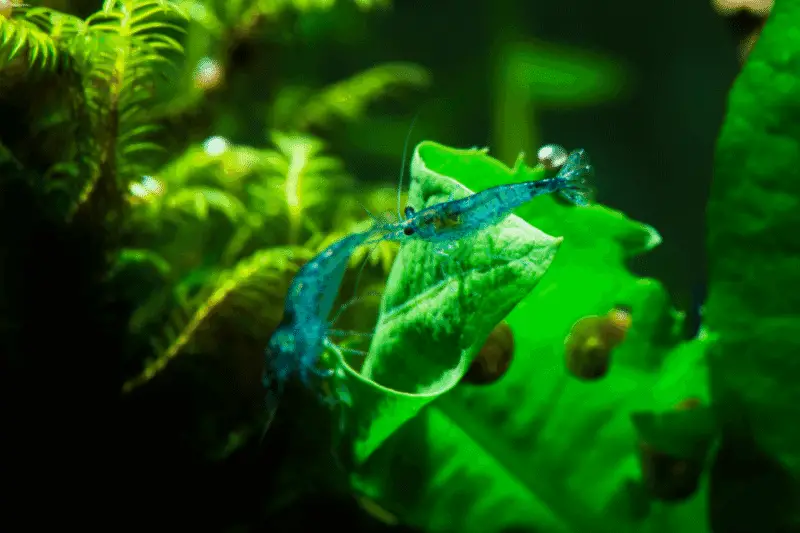
When it comes to shrimp, it is important to be careful when deciding your tank mates and to make sure y'all look for fish that are more timid and will go out your shrimp alone. Shrimp are often easy food for fish and most species of fish will try and feed off them. Blue Dream Shrimp are really simple to maintain and are also like shooting fish in a barrel to breed if desired. When feeding your shrimp, be conscientious non to overfeed them as this is one of their leading causes of decease .
If you want to know some other freshwater shrimp that would exist perfect for a Paludarium, so your in luck! See my commodity on fish that can alive in a freshwater Paludarium, which I encourage you to read.
| Proper name | Blue Dream Shrimp |
| Animal Class | Invertebrate |
| Type | Aquatic |
| Size | 1-1.25 inches |
| Lifespan | 1-2 years |
| Nutrition | Algae or algae wafers, decaying organic matter (dead plants, deceased fish/shrimp) |
22. Chinese Water Dragon

As Chinese Water Dragons are Arboreal creatures (tree dwelling), be sure to have plenty of branches for them to climb. H2o dragons also dear the h2o and can remain submerged for up to ninety minutes! When housing water dragons, multiple females or a male person and female can be housed together without whatever problems. All the same, avoid having two males in the same enclosure as they will become territorial and fight each other.
| Name | Chinese Water Dragon |
| Animal Class | Reptile |
| Type | Semi-aquatic |
| Size | up to iii.3 ft |
| Lifespan | x-15 years |
| Nutrition | Crickets, mealworms, vegetables, alive food (grasshoppers, roaches etc.) |
23. Carmine-eyed Crocodile Skink
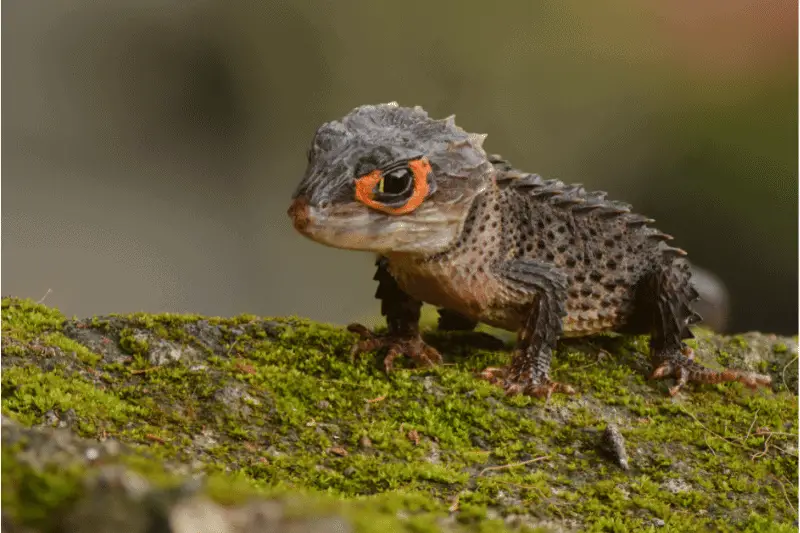
Carmine-Eyed Crocodile Skinks are a very secretive species and prefer to be on their own. The are willing to make an exception though for mothers and their offspring or during mating season. The Cherry-eyed crocodile skink is ane of the few species of skinks that vocalize when in distress. When startled, they often vomit, lose their tail, so freeze and play dead.
| Name | Red-eyed Crocodile Skink |
| Animal Class | Reptile |
| Blazon | Terrestrial |
| Size | 8-10 inches |
| Lifespan | half-dozen-12 years |
| Diet | Insects (fruit flies, pocket-sized crickets), mealworms, calcium supplement |
24. Tiger Salamander
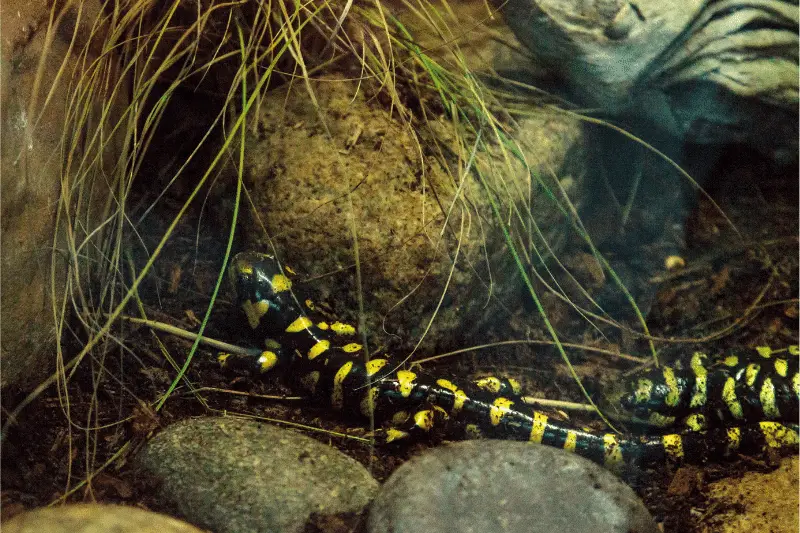
Tiger Salamanders are colorful amphibians that typically have vertical yellow stripes that run along their body. Their colors can vary nevertheless, as they have also been known to have a green or olive tinge or contain yellow blotches instead of stripes.
Unlike other salamander species, tiger salamanders like to dig burrows, so be sure to have some areas of your Paludarium that allows them to burrow on occasion. If you detect that your salamander may be missing its tail, there is no need to fret. Tiger Salamanders are able to regenerate entire limbs.
| Name | Tiger Salamander |
| Animal Course | Amphibian |
| Type | Terrestrial |
| Size | 7-13 inches |
| Lifespan | up to 25 years |
| Diet | Worms, snails, insects, slugs |
25. Toxicant Dart Frog
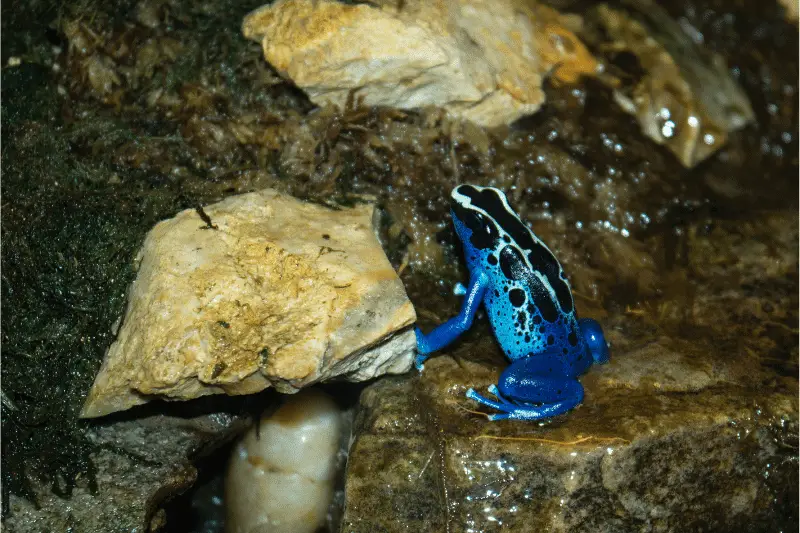
Poison Sprint Frogs are great for Paludariums every bit they come in a multifariousness of vibrant colors and are easy to maintain. They are awake and active during the day so volition provide great entertainment for your guests. Here's a random fact, a group of poisonous substance dart frogs is known as an "ground forces"!
If bred in captivity, these poison sprint frogs are non harmful at all. If they are obtained from the wild, so they will lose their poisonous potency overtime while in captivity. This is due to their toxicity existence maintained through ingestion of certain chemicals found only in the food they swallow in the wild.
| Name | Poison Sprint Frog |
| Creature Grade | Amphibian |
| Type | Terrestrial |
| Size | one-1.v inches |
| Lifespan | 12-twenty years |
| Diet | Small insects, ants, termites, fruit flies, pocket-sized crickets, tiny beetles |
26. Jackson Chameleon

Jackson Chameleons have also been called "3-Horned Chameleons" due to the three distinct horns found on males. Females practice not have horns so its easy to tell if your Jackson Chameleon is male or female. Like most chameleons, Jackson Chameleons can change color to resemble their environment and be used to camouflage themselves from predators. Their tail is as well super strong, and tin can support their whole body, so y'all may often run into them dangling from branches.
They will probably avoid the h2o then make sure to have substantial terrestrial plants that provides for good climbing and coverage. This detail species of chameleon doesn't make noises louder so a hiss and they don't use vocal sounds to communicate. So if your wanting a tranquillity pet for your Paludarium, this could exist the one for you!
Jackson Chameleons tin see what's in front of them and what's behind them at the same time! This is thanks to their uncanny ability to come across and process 2 separate images at the same time. Their eyes are able to swivel between 90 and 180 degrees and can move independently of each other.
| Name | Jackson Chameleon |
| Animal Class | Reptile |
| Type | Terrestrial |
| Size | nine-13 inches |
| Lifespan | 5-10 years |
| Nutrition | Alive insects (crickets, silkworms, roaches, hornworms, butterworms). Avoid waxworms or mealworms as they are harder for the chameleons to digest. |
Animals That Can Alive in a Paludarium Summary
Below is a summary tabular array containing information for a diverseness of animals that tin can live in a Paludarium. No thing your preference, there are plenty of options to aid y'all create the perfect Paludarium. I promise that this article has helped to make that decision easier and has provided useful information for whatever of the above pet options that you may be considering.
| # | Name | Brute Class | Type | Size | Lifespan | Diet |
|---|---|---|---|---|---|---|
| 1 | Burn down-Bellied Toad | Amphibian | Semiaquatic | 2-iii inches long | 10-15 years | Insects, Crickets, and Wax worms 3-4 times weekly |
| 2 | Springtails | Invertebrate | Semiaquatic | 0.2mm-10mm | ane week to 3 years | Leaf litter, fine roots, mold/mildew, fungi |
| iii | Yellow-Bellied Slider Turtle | Reptile | Semiaquatic | Male (5-9 inches) Female (8-13 inches) | upwardly to 30-40 years | Leaves, roots, algae, water insects, small slower fish, Commercial turtle pellets |
| iv | Vampire Crab | Invertebrate | Semi-terrestrial | upward to 2.v inches broad | 2-three years | Brine shrimp, bloodworms, crickets, green vegetables, algae wafers |
| 5 | Fire-Bellied Newt | Amphibian | Semiaquatic | 3-6 inches long | 10-25 years | Bloodworms (frozen or alive), earthworms, brine shrimp |
| 6 | Mudskipper | Amphibious Fish | Semiaquatic | up to 12 inches | 3-xx years | Crickets, flies, worms, meal worms, beetles, small fish, small venereal |
| vii | Spring Salamander | Amphibian | Semiaquatic | 5-7.5 inches long | eighteen.5 years | Insects, crustaceans, centipedes, millipedes, earthworms, snails, small spiders |
| 8 | African Bullfrog | Amphibian | Semiaquatic | half-dozen-10 inches long | 15-40 years | Crickets, mealworms, insects, mice, baby rats, other small amphibians |
| ix | Ribbon Snake | Reptile | Semiaquatic | 16-28 inches on average | 12-xx years | Modest frogs, tadpoles, small fish, spiders, earthworms, eggs, terrestrial vertebrates, and small newts |
| ten | Northern Water Serpent | Reptile | Semiaquatic | 2-4.v ft | upwardly to ix years | Fish, amphibians, small-scale reptiles, worms, leeches, small crayfish, pocket-sized birds, salamanders |
| 11 | Caiman Lizard | Reptile | Semiaquatic | two-4 ft | up to 10 years | Snails, crayfish, shrimp, crickets, chopped fruit |
| 12 | Guppies | Fish | Aquatic | Male person (0.6-1.four inches) Female (1.2-ii.4 inches) | 1-3 years | Alkali shrimp, algae, microorganisms, flakes, pellets |
| xiii | Thai Micro Crab | Invertebrate | Aquatic | up to 0.5 inches | up to i.five years | Shrimp food, sinking pellets, algae |
| xiv | Mystery Snails | Invertebrate | Aquatic | 1-2 inches | up to one year | Algae, dead/rotting plants, fish/invertebrate pellets, blanched vegetables |
| 15 | Tadpoles | Amphibian | Aquatic | Differs based on species. (1.iii-8 inches) | Lifecycle from tadpole to frog between 12-xvi weeks. | Algae, leaves/roots of aquatic plants, dead insects. Every bit they grow legs they will start to be more than carnivorous. |
| sixteen | Axolotl | Amphibian | Aquatic | half-dozen-xviii inches | Up to 15 years | Mollusks, worms, insect larvae, pocket-sized fish, brine shrimp |
| 17 | Nerite Snail | Invertebrate | Aquatic | up to ane inch | ane-2 years | Algae, fair-skinned vegetables |
| 18 | Aquatic Isopods | Invertebrate | Aquatic | 0.3-0.5 inches | 9-20 months | Decaying institute fabric, algae, sinking pellets |
| xix | Electrical Blue Crayfish | Invertebrate | Aquatic | 4-6 inches | v-six years | Invertebrate pellets, blanched vegetables (carrots, zucchini, spinach), algae wafers |
| 20 | Orange Mexican Dwarf Crayfish | Invertebrate | Aquatic | up to one.6 inches | two-iii years | Worms, brine shrimp, plants, vegetables, algae wafers, pellets |
| 21 | Bluish Dream Shrimp | Invertebrate | Aquatic | one-1.25 inches | 1-2 years | Algae or algae wafers, decomposable organic affair (dead plants, deceased fish/shrimp) |
| 22 | Chinese Water Dragon | Reptile | Semiaquatic | up to 3.3 ft | 10-15 years | Crickets, mealworms, vegetables, live food (grasshoppers, roaches etc.) |
| 23 | Cerise-eyed Crocodile Skink | Reptile | Terrestrial | 8-ten inches | 6-12 years | Insects (fruit flies, small crickets), mealworms, calcium supplement |
| 24 | Tiger Salamander | Amphibian | Terrestrial | 7-13 inches | up to 25 years | Worms, snails, insects, slugs |
| 25 | Poisonous substance Dart Frog | Amphibian | Terrestrial | ane-1.5 inches | 12-twenty years | Minor insects, ants, termites, fruit flies, modest crickets, tiny beetles |
| 26 | Jackson Chameleon | Reptile | Terrestrial | 9-13 inches | 5-ten years | Alive insects (crickets, silkworms, roaches, hornworms, butterworms). Avert waxworms or mealworms as they are harder for the chameleons to digest. |
Source: https://terrariumsandfairies.com/these-animals-can-live-in-a-paludarium/
Posted by: gentilelovent.blogspot.com

0 Response to "What Animals Can Live In A 2 Gallon Tank"
Post a Comment